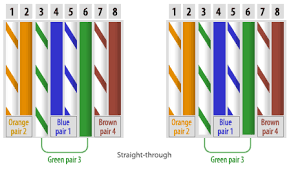Cat 5

Cat 5 is an abbreviation used for Category 5 cables. This cable constitutes of twisted wires and is used for networking. Since 2001, the Cat 5e variant of this cable has been used in computer networks. It has a performance of 100 MHz and is mostly used for establishing Ethernet connections over twisted cables. It can be used up to 2.5 GBase-T, but it is mostly used to run at 1000Base-T speeds.
They are also used to transmit signals over telephones and videos. However, they mostly connect using punch-down blocks and modular connectors. Most of the cables are unshielded; they do not have any additional insulation coating. They largely rely on the balanced line twisted pair design and differential signaling to ensure noise rejection.
Standard Specification of Cat 5 Cables
- The specification for Cat 5 cables is defined under the ISO/IEC 11801, IEC 61156, and EN 50173. Its standard specification was defined under ANSI/TIA/EIA-568-A. It clearly defines the character of the cable and the requirement to work efficiently. The characteristics are defined based that the performance at 100 MHz frequencies.
- The Cat 5 cable is available in both solid conductor and stranded forms. The stranded form of the cable is used when the user wants more flexibility and bending without breaking. The patch cables are stranded. While the solid conductor cables are used where the user requires permanent wiring, they have a solid core though less flexible. They are comparatively more durable. The category of the cable can be determined by checking the printing on the cable's jacket.
- The conductive material for the Cat 5 cable should be made up of pure copper. There has been a decline in the usage of Cat 5 cables; instead, the industry has seen counterfeit cables of the Copper Clad Aluminium variety have replaced them. These cables are of low-grade quality and affect the quality and performance of the transmission. The manufacturers and cables that install these counterfeit cables are subjected to legal liabilities.
Variants and Comparisons
- Through the course, several modifications were done to the Cat 5e specification of the table. The specifications were revised and updated to increase the crosstalk on the Cat 5e cable.
- The cable bandwidth is 100 MHz, and they are physically built similarly. Most of the Cat 5 cables meet the specification requirement of the Cat 5e cables. However, it is unnecessary in every case that the Cat 5 cable meets the requirement for Cat 5e cables. The use of category 5 cables was reduced in 2001 rather. Cables replaced them with 5e specifications.
- More improvements were made in the Category 6 specifications cables. They extended the frequency of response. It also reduced the crosstalk as compared to the category 5e cables. The category 6 cables provided 250 MHz bandwidth.
- Several variants for Category 6 were also released. The category 6A cable had a bandwidth of 500 MHz. Both variants of the Cat 6 cable worked with Cat 5 and Cat 5e cables.
Applications of Cat 5 Cables
- The primary application of the category 5 cable is to use it as a structured cable in networking. They were used for Ethernet connection over the twisted pair cables.
- The standard Category 5 cables are suitable for 10 BASE-T, 100 BASE-TX, and 1000 BASE-T cables. It supports frequency bandwidth upto 100 MHz.
- It is also used to carry other signals over them. It can carry both video and telephone signals over the Cat 5 cables. It can transmit both analog and digital video.
|

 For Videos Join Our Youtube Channel: Join Now
For Videos Join Our Youtube Channel: Join Now










